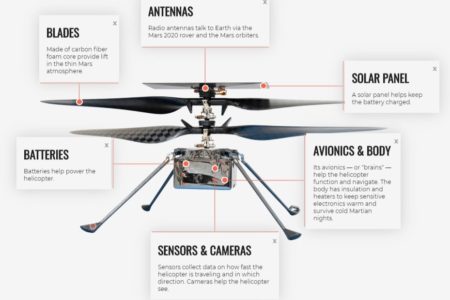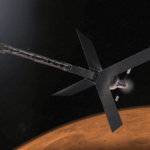April 1, 2020 – I know it’s April Fool’s Day but no fooling, in my inbox news file comes this NASA story published on March 26th about the Mars helicopter having run through its final Earth-bound test before being packaged to go along with the Mars 2020 rover named Perseverance.
What’s the big deal about flying a robot helicopter on Mars?
Here on Earth, helicopter’s gain altitude as the blades push against an atmosphere that is a one hundred times denser than that which is found on Mars. So you can’t use helicopter designs that work here to fly there. NASA has described what they have invented as a proof of concept and purely a demonstration of what is possible in the future.
So how can a helicopter fly in such thin air?
- The Mars helicopter has Martian gravity in its favour, approximately one-third that of Earth. So getting off Martian ground doesn’t require the same amount of force as here on our home planet.
- The Mars helicopter weighs 1.8 kilograms (4 pounds) here on Earth. On Mars that translates to a relative weight of 0.67 kilograms (1.5 pounds).
- The Mars helicopter blade span is 1.2 meters (under 4 feet). The rotor spin rate reaches 2,400 revolutions per minute (rpm). Compare that to spin rates of between 250 and 600 rpm for helicopters operating here. The reason for the higher spin rate is to gain the necessary lift to counter the thinness of the atmosphere.
How far will the helicopter fly when it is released?
The plan is to limit flights to 90 seconds or less, distances of 300 meters (980 feet) or less, and initially at elevations of 3 to 5 meters (approximately 10 to 15 feet). The distance limit is largely determined by the onboard 350-watt lithium-ion batteries which are recharged using the onboard solar panel. If successful in these early flights, the helicopter may exceed the height limit in later flights reaching as much as 100 meters (330 feet) in altitude.
How will the helicopter navigate?
Any attempt to control the helicopter from Earth in real-time would be impossible. The signal latency between 4 and 14 minutes in sending commands from Earth to Mars makes it imperative that the helicopter fly autonomously. It has no science instrumentation on board but does include a number of sensors to orient it during takeoff, flight, and landing. At all times it will stay in communication with Perseverance.
When will it fly and how often?
The plan is to release the helicopter after Perseverance arrives on Mars and then begin a series of short-hop tests over 30 Martian days. The first flight will be next spring and will be 20 to 30 seconds in length and will only involve hovering a meter or so above the surface. If successful, the plan is for at least four flights during the 30 days. If successful you can bet that NASA will build robot helicopters for future missions to the Red Planet.
Will Perseverance and the helicopter go ahead despite the COVID-19 pandemic?
The mission is one of the few at NASA this is sticking to schedule largely because the optimal launch window this summer between July 17th and August 5th, if missed will mean a wait of two years before the two planets align properly for the next attempt.
Perseverance should reach the Martian surface next February. It won’t be long thereafter before the helicopter takes flight proving that we have the technological capacity to fly on Mars.
We can only hope, we have a similar capacity to control and beat down the pandemic here on Earth and get through the next four months until the launch date.
















